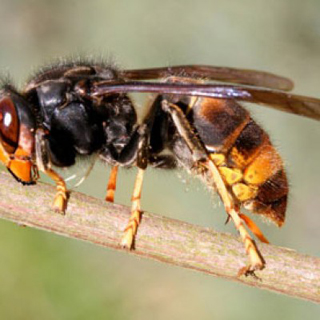 I make no apologies for starting this month’s blog with an update on the Asian Hornet. The good news is that the sighting at a Plymouth apiary has not been confirmed and no further evidence or reports of Asian Hornet activity in the area have been received. However, the Woolacombe sighting in September galvanised the National Bee Unit (NBU) into action, implementing its well-established protocol for containing such anticipated outbreaks. The nest occupants were treated with pesticide and the nest removed for analysis, since which time no further live Asian Hornets have been seen within the two mile surveillance zone set up in Devon which was scoured by bee inspectors. We must all remain vigilant, however, and report any sightings to the authorities.
I make no apologies for starting this month’s blog with an update on the Asian Hornet. The good news is that the sighting at a Plymouth apiary has not been confirmed and no further evidence or reports of Asian Hornet activity in the area have been received. However, the Woolacombe sighting in September galvanised the National Bee Unit (NBU) into action, implementing its well-established protocol for containing such anticipated outbreaks. The nest occupants were treated with pesticide and the nest removed for analysis, since which time no further live Asian Hornets have been seen within the two mile surveillance zone set up in Devon which was scoured by bee inspectors. We must all remain vigilant, however, and report any sightings to the authorities.
Asian hornets pose no greater risk to human health than a bee, though they are a threat to honey bee colonies, as the hornets prey on honeybees, disrupting the ecological role which they provide and damaging commercial beekeeping activities. This is why DEFRA (or APHA, the Animal and Plant Health Agency as they are now called) and the NBU take quick action to identify and destroy their nests.
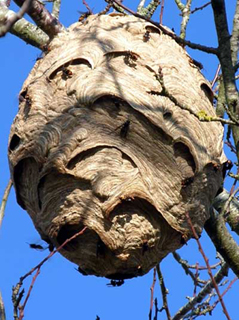 The species arrived in France in 2004 and is now common across large areas of Europe as a result of the French taking a laissez-faire attitude to its arrival. It was discovered for the first time in the British Isles in Jersey, Alderney and Gloucestershire last summer (2016). Asian hornets can be confused with their larger native European hornet counterparts, but the Asian hornet abdomen is almost entirely dark while the European hornet’s abdomen is largely yellow. As it is possible Asian hornets could reappear in the UK, members of the public alongside the nation’s beekeepers are urged to report any suspected sightings.
The species arrived in France in 2004 and is now common across large areas of Europe as a result of the French taking a laissez-faire attitude to its arrival. It was discovered for the first time in the British Isles in Jersey, Alderney and Gloucestershire last summer (2016). Asian hornets can be confused with their larger native European hornet counterparts, but the Asian hornet abdomen is almost entirely dark while the European hornet’s abdomen is largely yellow. As it is possible Asian hornets could reappear in the UK, members of the public alongside the nation’s beekeepers are urged to report any suspected sightings.
So serious is the threat to our delicate ecological balance with regard to the honey bee, a mobile phone App has been produced, available for download from Apple and Android App Stores. Additionally, members of the public can report sightings by email to alertnonnative@ceh.ac.uk with a photo or on the Non-native Species Secretariat website. Further details on the appearance of an Asian hornet can be found on the Bee Base guide or the non-native species identification guide.
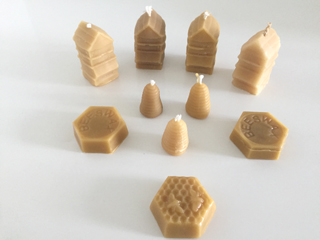 So what’s happening in the apiary? Well, at the moment the bees are still bringing in ivy nectar and pollen, though their days are curtailed by the reducing daylight hours. Nonetheless, I feel quite confident that there will be enough winter stores available to see the bees through the winter. When I started beekeeping 20-odd years ago, 45lbs of stores was deemed adequate for a colony’s survival through the winter.
So what’s happening in the apiary? Well, at the moment the bees are still bringing in ivy nectar and pollen, though their days are curtailed by the reducing daylight hours. Nonetheless, I feel quite confident that there will be enough winter stores available to see the bees through the winter. When I started beekeeping 20-odd years ago, 45lbs of stores was deemed adequate for a colony’s survival through the winter.
Today that has increased to 50-55lbs of stores, depending on the colony! This is mainly down to climate change (are you listening, Trump?) and our milder and wetter winters. 20 years and more ago the bees would be confined to their hives by the cold winters we experienced then, clustering tightly together for warmth and eating their way through their stores quite slowly. Nowadays, the bees can be seen flying virtually throughout the year, there being little difference between winter and summer in terms of suitable flying conditions, with the consequent depletion of their stores at a much greater rate than before during the winter months.
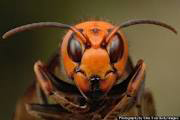 I normally like to place some sugar candy or fondant on top of the brood nest in January, just as a precaution against starvation, but the advice today is that this should be done earlier, perhaps as early as the end of November if you are not sure of the amount of stores in the hive. I will check at some point by hefting the hives (lifting them carefully from one side, just half an inch off the ground, then lifting the other side by the same amount). If the hive appears to be “nailed” to the ground, there are likely to be sufficient stores inside without further checking. If you are in danger of almost tipping the hive over by doing this, however, then the bees will need to be fed fairly promptly. Crude, but effective!
I normally like to place some sugar candy or fondant on top of the brood nest in January, just as a precaution against starvation, but the advice today is that this should be done earlier, perhaps as early as the end of November if you are not sure of the amount of stores in the hive. I will check at some point by hefting the hives (lifting them carefully from one side, just half an inch off the ground, then lifting the other side by the same amount). If the hive appears to be “nailed” to the ground, there are likely to be sufficient stores inside without further checking. If you are in danger of almost tipping the hive over by doing this, however, then the bees will need to be fed fairly promptly. Crude, but effective!
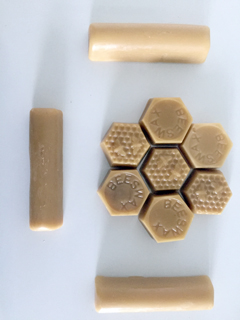 My daughter wanted some beeswax for her quilting threads and asked me to take her some. Unfortunately, all my beeswax is in large lumps weighing a pound or two (it’s easier to store like that) and it wouldn’t have been easy for her to use in that form. I therefore set to, melting down some of these large blocks, filtering them to remove excess propolis and extraneous impurities, and subsequently casting them into blocks. I have three moulds suitable for this, one producing hexagons embossed with the word “Beeswax”, another with bees on the comb, the third producing utilitarian blocks about twice the weight of the hexagons.
My daughter wanted some beeswax for her quilting threads and asked me to take her some. Unfortunately, all my beeswax is in large lumps weighing a pound or two (it’s easier to store like that) and it wouldn’t have been easy for her to use in that form. I therefore set to, melting down some of these large blocks, filtering them to remove excess propolis and extraneous impurities, and subsequently casting them into blocks. I have three moulds suitable for this, one producing hexagons embossed with the word “Beeswax”, another with bees on the comb, the third producing utilitarian blocks about twice the weight of the hexagons.
In unearthing these moulds, I also came across two other moulds, one in the form of a traditional beehive, the other in the shape of a skep. My OCD then came to the fore and I have been making blocks and skeps and beehives over the past few days like there’s no tomorrow (much to my wife’s amusement!). I shall be adding these to my sales stand at Veryan Market (see our Facebook page). Anyway, this is just another example of how all hive products can be utilised in one way or another, with nothing coming out of the hive ever needing to be wasted (and my daughter got her hexagons and was over the moon – I think she might be OCD as well, though I can’t think where that came from!).
 So, until next month, keep your eyes peeled for the unusual looking Asian Hornets and their nests. I said last month that the nests are built very high up in evergreen trees. Well, it appears that these main nests can also be found lower down, though again in bushes or trees, so you don’t just have to trip over unseen obstacles whilst gazing high into the heavens in your hunt for them, they can be found at head height sometimes. Here’s hoping you don’t find any!
So, until next month, keep your eyes peeled for the unusual looking Asian Hornets and their nests. I said last month that the nests are built very high up in evergreen trees. Well, it appears that these main nests can also be found lower down, though again in bushes or trees, so you don’t just have to trip over unseen obstacles whilst gazing high into the heavens in your hunt for them, they can be found at head height sometimes. Here’s hoping you don’t find any!
Colin Rees – 01872 501313 – colinbeeman@aol.com

